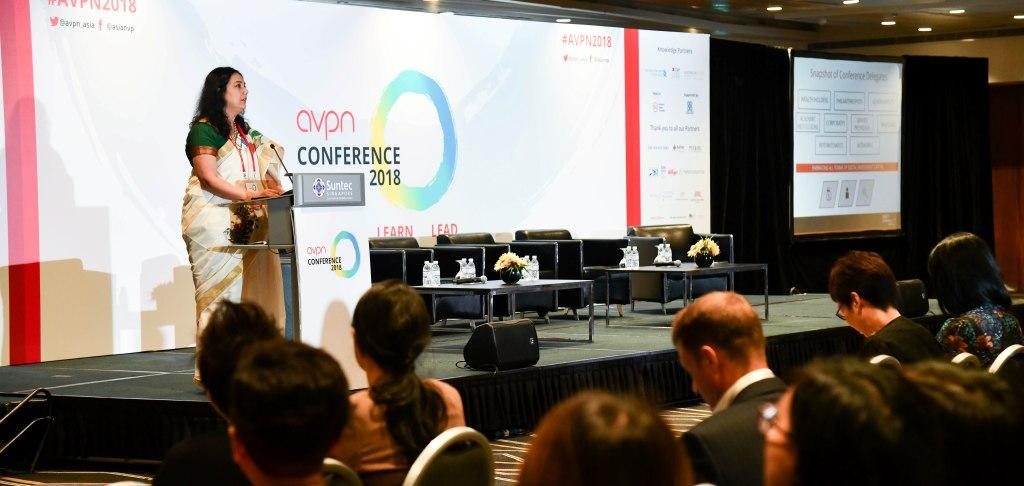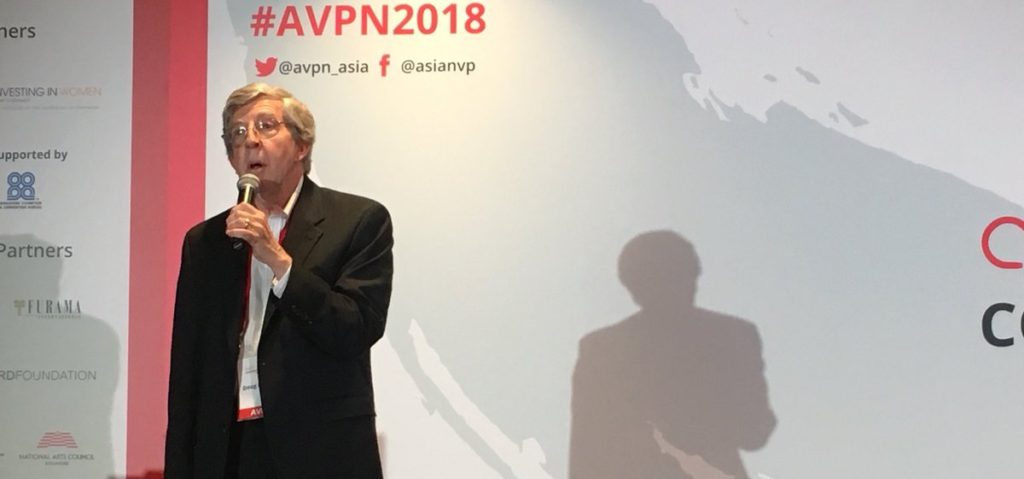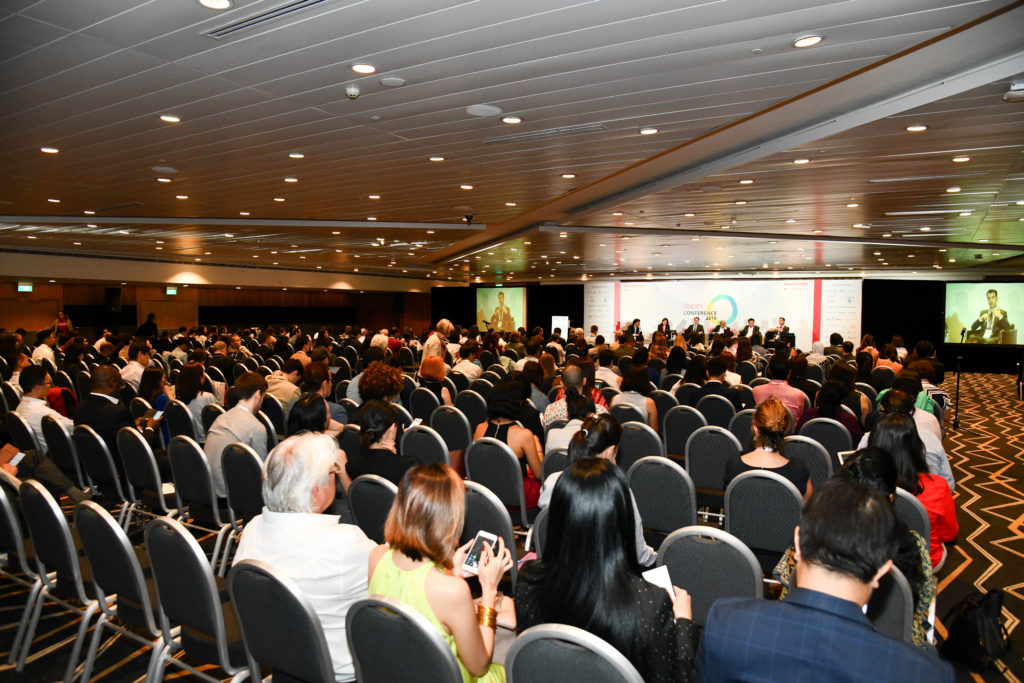The social and environmental problems we’re facing will require far more resources than we have so far put into them. As a rough indicator, estimates of money to meet the Sustainable Development Goals are eye-watering. If we are to come close, we will need to work together and we will need to draw on new means of resourcing. This was really the premise of the 2018 AVPN conference and its twin themes of collaboration and impact.

Naina Batra, Chairperson and CEO at AVPN.
It’s always big, as one participant remarked, but this year’s gathering in Singapore between 4 and 7 June was bigger than ever, with a shade over a thousand participants. This is testament both to the urgency of the questions at issue and the network’s drawing power, reflected not only in its 493 members from 32 countries, but also in the spread of the organisations present: social venture funds, family offices, businesses, intermediaries of all shapes and sizes, social purpose organisations (the preferred nomenclature in the region for NPOs), even venture capital firms who specialise in the impact investment field – oh, and don’t forget foundations.
In her opening remarks, AVPN CEO Naina Batra stressed that, if we are to come close to finding the resources needed, all the different forms of social finance participants embraced have roles to play along what the network is calling the continuum of capital. A report exploring this idea was released just prior to the conference. The featured themes of collaboration and impact ran across the issue areas discussed, most of them of special importance in the Asian region: climate change, education, healthcare, sustainable livelihoods and gender empowerment. ‘Collaboration is hard work, but we must do it,’ affirmed Singapore’s Minister for Culture, Community and Youth, Grace Fu, in her keynote address and she urged participants to ‘be bold in imagining a better future.’

Sesame Workshop and Galli Galli Sim explained their model in educating children at the critical age of 4-5. Photo: @JohnDGarrity
Meanwhile, in the opening session on gender empowerment, the conference made its own impact, featuring a guest appearance from Chamki, a muppet from the Indian co-production of Sesame Street, who underlined the ‘power of muppets and media’ in shaping attitudes. The various national incarnations of Sesame Street had been shown to have a positive effect on gender attitudes in those countries among both girls, boys and parents. Other presenters underlined the beneficial effects empowering women could have on the whole of a society. Ingrid Stange of Partnership for Change in Norway noted that that country had been able to transform itself from one of Europe’s poorest into one of its richest not just because it had discovered oil, but because of a conscious decision to encourage women to enter the workplace, through a combination of family planning and care, training and the provision of opportunities. In other words, as Sarah Pearson of Innovation Xchange, set up by Australia’s Department of Foreign Affairs and Trade (DFAT) put it, women’s empowerment is ‘not just right on principle, it’s sensible.’ However, Yamini Atmavilas of the Gates Foundation in India observed the difference between access and availability. It will be of no use encouraging women to enter an environment where they can’t make a living. Opportunity, regulation and cultural attitudes were all important here, reinforcing the general conference message of the need for cooperation.
Climate change: an ‘almost-physical fear’
Sian Ferguson of the UK’s Ashden Trust spoke of the role philanthropy could play in combatting climate change. Moving to a world economy powered by renewable energy (a necessary but insufficient step to tackling global warming) required appropriate legislation and, again, philanthropy could help create the necessary political momentum. India and China were seen as huge markets for renewables and initial investments by philanthropy and social investment could help move those markets to the stage where the economic benefits became apparent. Beyond the prospects for positive action, though, the mood was sombre. The fear of climate change is becoming almost physical, said Ferguson. She spoke of the need, above all, for climate funders of whatever type to communicate and to publicise what they are doing and to urge others to join them.
 Scale
Scale
Again and again, delegates remarked that solutions to the various problems under discussion do exist but they are often localised. One crucial barrier to scaling them up lies in the reluctance of local and national governments to embrace them, often because they were sceptical of the economics involved. Jenna Liang of the Synergos Institute spoke of a programme to prevent drowning in Bangladesh (the leading casue of death in the country for children under the age of five). The most effective method of prevention had been found to be the establishment of community-based daycare centres. In the face of initial uncertainty on the part of other funders and the Bangladeshi government, Synergos had shown that daycare centres provided jobs, reduced healthcare costs, freed mothers’ time and equipped the children involved with lifeskills. In other words, as well as providing a good in themselves, they had other practical benefits and incidentally hit a number of SDG targets. For Synergos, said Liang, the formula was find out where the gaps are, get the economic model right and get local buy-in by co-creation. However, there is no single innovation that will magically transform a problem, said Harvey Koh of FSG. To produce systemic change, you need to pull many levers.
Collaboration – still more honoured in the breach than the execution
The basis of the conference and indeed much discussion in the philanthropy world, is the need for collaboration, yet while it is much advocated it is far less often practised. Why? The greatest barriers are ego and fear, believes Edwin Ou of the Skoll Foundation. Funders are reluctant to change. They have their own institutional cultures, are used to determining their own priorities and, in the case of foundations at least, set a premium on their independence. So try asking them if they like wasting money, suggested Ou because if they fail to cooperate, they are simply perpetuating inefficient funding models. Annie Chen of RS Group in Hong Kong also urged fellow funders to set aside ego and to build a stronger social investment ecosystem. One merit of the SDGs is that at least they give all the sectors with an interest in social change a framework in which to work together.
The merits of both/and over either/or
While philanthropy and impact investment are seen as distinct, that distinctiveness should not be confused with dichotomy. Philanthropists can and do engage in the practice and a number of sessions featured impact investment initiatives undertaken by foundations, notably the Sainsbury Family Charitable Trusts (SFCT) from the UK and the Sasakawa Peace Foundation in Japan. Combining the two brought both benefits and challenges. ‘Philanthropy used to feel a lot simpler,’ said Mark Sainsbury of SFCT. We used to focus on giving, he said, ‘and left investing to the men in grey suits,’ but this had produced an unhelpful dissonance which was behind some of the market failures the world has witnessed over the last decade. As a result, SFCT had decided to embrace impact investing. Annie Chen said something similar. RS Group considers itself to be a ‘100 per cent impact investor. We look at investment as a way to create good, not problems.’ Yet, there remain distinctions between philanthropists and straight impact investors. Impact investment, said one speaker, seeks a return that is at least partly financial, so the market is boss, as they put it. Philanthropy, on the other hand, is free to determine its own criteria for engagement.
Philanthropic money could dovetail with impact investment here by absorbing the risk attendant on untried start-ups. The view that impact investment must entail some form of sacrifice could also act as an inhibiting factor, however, there is no need to see impact investment as an ‘ethical posture’, argued Mark Sainsbury. There is money to be made, he said and he urged funders to talk to their fund managers.
Felix Oldenburg of the Association of German Foundations noted psychological and regulatory considerations that divide the attitude to investment of philanthropists on the one hand and more commercial investors on the other, but the model that has worked in the past, will not work going forward, he argued. In addition, while this difference in outlook might make collaboration between them difficult, the most effective collaborations are where philanthropic money and impact investment have combined.

‘It used to be said that most of what you learn at university, you learn in informal discussions with your peers, not in the more formal sessions of lectures and seminars. If the same is true of philanthropy conferences, then AVPN must rank high as an educational experience.’
So how can more money be brought into impact investment? China, as ever, offers a considerable potential source. Ma Wei Hua of the China Global Philanthropy Institute said that the country is changing from a high-speed to a high-quality economy and impact investment could provide the means for it to do this, a view endorsed later in the conference by Xu Yong Guang of the Narada Foundation when he said that China is ‘ready to be a major player in the impact investing and social enterprise sector’.
However, intermediaries are still lacking, particularly in Asia, to point the way to good deals, as are incubators which could help investees become bankable in the first place. Philanthropic money could dovetail with impact investment here by absorbing the risk attendant on untried start-ups. The view that impact investment must entail some form of sacrifice could also act as an inhibiting factor, however, there is no need to see impact investment as an ‘ethical posture’, argued Mark Sainsbury. There is money to be made, he said and he urged funders to talk to their fund managers.
Overall, there is still more confusion than clarity, claimed Harvey Koh of FSG in a later session. The idea that you can get market-rate returns is being translated into ‘you must get market-rate returns,’ he said, which closes off many possible investments
Rethinking the role of philanthropy
With the stress laid on impact investment, it was easy to feel that the role of philanthropy was being overlooked. However, if veteran ‘philanthropoids’ sometimes felt they had strayed into the wrong conference, a plenary session on strategic philanthropy and a breakout session entitled Unlocking the potential of Global Philanthropy might have reassured them.
In Asia generally, philanthropy is becoming more intentional, according to Raman Sidhu of the Switzerland-based Lorinet Foundation which works extensively in South-East Asia and Mongolia. It is using data and analytics more effectively and more resources are going to areas like healthcare, education and quality of life. Asian philanthropists are beginning to export their expertise to other regions. There is also more awareness of philanthropy’s role, he argued, both as a complement to state action and as a stimulant to government to act where it was slow to do so.
In fact, if there was one take-away from the conference that stood out above the rest: if we want to make a dent in the social and environmental problems that face us, we will have to work together – not just the different elements of philanthropy and social investment, but all sectors of society. This seems to be not just an Asian, but a global truth.
Inevitably, there is more to do. Ludwig Forrest of the King Baudouin Foundation in Belgium advocated the use of cross-border giving mechanisms like Transnational Giving Europe (TGE) to stimulate donors to give outside their own countries. TGE in fact is currently exploring the idea of extending the network beyond Europe.

‘Another role for philanthropy, suggested Olivia Leland of Co-impact, is to be catalytic at bringing in more funding and in exploring the role each form can play along the continuum of capital.’
Paul Carrtar of IVPC reminded us that, outside government funding, philanthropy is still the biggest of social impact capital but, he added, it needs to rethink its role in the light of the new means at its disposal, the greater needs and the fact that, as more than one participant pointed out, in a low-interest world, grantmaking is becoming increasingly strained. Felix Oldenburg of the Association of German Foundations agreed that soon, impact investing would be more important than grantmaking but at the moment, many governments were putting obstacles in the way of impact investing. Instead, they should be making it hard not to invest with impact, he argued. Another role for philanthropy, suggested Olivia Leland of Co-impact, is to be catalytic at bringing in more funding and in exploring the role each form can play along the continuum of capital.
Doug Miller bows out
The conference also marked the departure of Doug Miller, who is stepping down from his role founding chair of AVPN and a key figure in the venture philanthropy landscape globally.

Founder and chairman Doug Miller spoke about his personal learnings to date: ‘It is important that we integrate human, financial and intellectual capital, invest more in teams and collaborate more on sector basis.’ Photo: @avpn_asia
In his parting remarks to the gathering, he observed that there is still a lot to do in addressing the problems which are almost too familiar to require repetition – poverty, inequality, climate change and the dramatic growth in population. He urged participants to approach these problems with ‘urgency and outrage’.
The experience of the conference
It used to be said that most of what you learn at university, you learn in informal discussions with your peers, not in the more formal sessions of lectures and seminars. If the same is true of philanthropy conferences, then AVPN must rank high as an educational experience. As Naina Batra remarked at the beginning of proceedings, the conference provides an opportunity for those attending to the time and freedom to talk and to explore common ground and that opportunity was seized upon. The conference app registered over 2,700 hits and the number of impromptu contacts must have been much higher. As with last year’s conference, there was a greater eagerness to meet and talk to others than is apparent at many similar events which seems to reflect a tremendous desire throughout the region to explore ways to solve its problems – and there was a clear sense both from the conference themes and from the conversations it gave rise that this can only be done in concert. In fact, if there was one take-away from the conference that stood out above the rest: if we want to make a dent in the social and environmental problems that face us, we will have to work together – not just the different elements of philanthropy and social investment, but all sectors of society. This seems to be not just an Asian, but a global truth.
 As for the formal sessions – and as with any conference – you take what you can from them. With a thousand people to try and satisfy, these offered great variety and sheer number (there were 58 of them, all told). This account has only picked out a few themes. Topics covered also included the role of universities, impact measurement, next generation philanthropy and corporate social responsibility. Everyone represented at the conference got a turn: AVPN’s Policy Network initiative was incorporated into the conference, with sessions exploring individual policy developments in different countries and the Deal Share live sessions provided exposure of some of the projects AVPN members are currently supporting. The final morning of the conference was given over to workshops that explored some of the themes in greater detail: B Corps and business for good, impact investing and designing a gender lens investing action plan. It’s inevitable, though, that, from a thousand people, you will find some who are dissatisfied. One person I spoke to felt that the sessions were ‘light’, but conceded that the real merit of the conference was in the networking opportunities it offered. On the other hand, another described those same opportunities as ‘hanging around, drinking terrible coffee’. You can’t please everyone. Again, a foundation staff member or a dyed-in-the-wool philanthropoid might have thought there was too much talk of deal-flow, asset classes and risk-adjusted returns.
As for the formal sessions – and as with any conference – you take what you can from them. With a thousand people to try and satisfy, these offered great variety and sheer number (there were 58 of them, all told). This account has only picked out a few themes. Topics covered also included the role of universities, impact measurement, next generation philanthropy and corporate social responsibility. Everyone represented at the conference got a turn: AVPN’s Policy Network initiative was incorporated into the conference, with sessions exploring individual policy developments in different countries and the Deal Share live sessions provided exposure of some of the projects AVPN members are currently supporting. The final morning of the conference was given over to workshops that explored some of the themes in greater detail: B Corps and business for good, impact investing and designing a gender lens investing action plan. It’s inevitable, though, that, from a thousand people, you will find some who are dissatisfied. One person I spoke to felt that the sessions were ‘light’, but conceded that the real merit of the conference was in the networking opportunities it offered. On the other hand, another described those same opportunities as ‘hanging around, drinking terrible coffee’. You can’t please everyone. Again, a foundation staff member or a dyed-in-the-wool philanthropoid might have thought there was too much talk of deal-flow, asset classes and risk-adjusted returns.
But whether you’re sceptical or enthusiastic about the AVPN’s conference and its work generally, or somewhere in between, it’s undeniably an important part of the infrastructure of the Asian social investment scene. As such, it is in a position to shape developments, as well as being shaped by them. If you’re interested in Asian philanthropy and social investment, you can’t ignore it. And if you’re not interested in Asian philanthropy and social investment, why aren’t you? It’s a phenomenon of growing significance for the region’s future and is set to become more so.
Andrew Milner is associate editor of Alliance magazine



Comments (0)